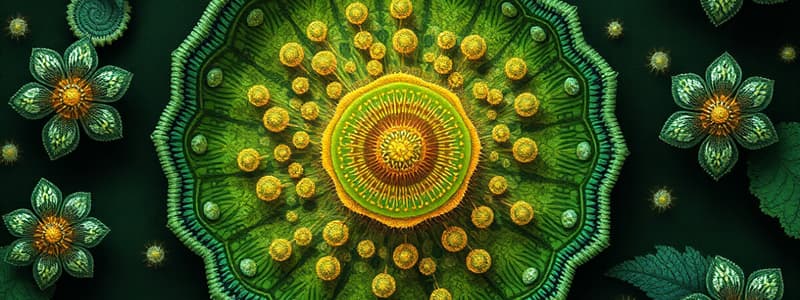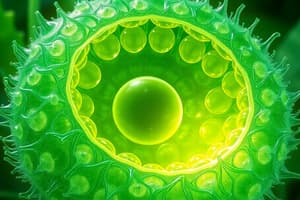Podcast
Questions and Answers
What is the primary component of the plant cell wall?
What is the primary component of the plant cell wall?
- Lignin
- Cellulose (correct)
- Chitin
- Pectin
Chloroplasts are found in both plant and animal cells.
Chloroplasts are found in both plant and animal cells.
False (B)
What is the main function of the large central vacuole in plant cells?
What is the main function of the large central vacuole in plant cells?
To maintain turgor pressure and store substances.
The process by which plants convert light energy into chemical energy is called ______.
The process by which plants convert light energy into chemical energy is called ______.
Match the following organelles in plant cells with their functions:
Match the following organelles in plant cells with their functions:
Which structure connects adjacent plant cells and facilitates communication?
Which structure connects adjacent plant cells and facilitates communication?
Plant cells do not require energy from cellular respiration.
Plant cells do not require energy from cellular respiration.
What is the primary function of chlorophyll in chloroplasts?
What is the primary function of chlorophyll in chloroplasts?
The rigid outer layer that surrounds the plant cell membrane is called the ______.
The rigid outer layer that surrounds the plant cell membrane is called the ______.
Which of the following structures is absent in animal cells?
Which of the following structures is absent in animal cells?
Flashcards
Plant Cell Wall
Plant Cell Wall
A rigid outer layer that provides support and protection to plant cells.
Chloroplast
Chloroplast
Organelle responsible for photosynthesis in plant cells.
Photosynthesis
Photosynthesis
Process by which plants use light energy to produce food.
Central Vacuole
Central Vacuole
Signup and view all the flashcards
Turgor Pressure
Turgor Pressure
Signup and view all the flashcards
Plasmodesmata
Plasmodesmata
Signup and view all the flashcards
Eukaryotic Cell
Eukaryotic Cell
Signup and view all the flashcards
Cellulose
Cellulose
Signup and view all the flashcards
Difference Plant vs Animal Cells
Difference Plant vs Animal Cells
Signup and view all the flashcards
Mitochondria
Mitochondria
Signup and view all the flashcards
Study Notes
Plant Cell Structure
- Plant cells are eukaryotic cells, meaning they have a nucleus and other membrane-bound organelles.
- Unlike animal cells, plant cells are characterized by several unique structures, contributing to their specific functions and overall morphology.
- Their rigid cell wall provides structural support and protection.
- The cell wall is composed primarily of cellulose, a complex carbohydrate.
- The cell wall is a defining feature that differentiates plant cells from animal cells.
Specialized Organelles in Plant Cells
- Chloroplasts: These organelles are crucial for photosynthesis, the process by which plants convert light energy into chemical energy (sugars).
- Chloroplasts contain chlorophyll, a pigment that absorbs light energy for photosynthesis.
- Chloroplasts are double-membraned organelles, with an inner and outer membrane.
- Inner thylakoid membrane folds to form grana, stacks of thylakoids.
- The stroma is the fluid-filled space surrounding the grana.
- Large Central Vacuole: This is a prominent feature of plant cells.
- The vacuole is a fluid-filled sac that occupies a large portion of the plant cell's volume.
- This vacuole maintains turgor pressure, which is essential for plant support.
- The vacuole stores water, nutrients, and waste products.
- It also plays a role in maintaining the cell's shape and size.
- Cell Wall: A rigid outer layer surrounding the cell membrane.
- Provides structural support, protection, and maintains cell shape.
- Composed primarily of cellulose, a complex carbohydrate.
- The cell wall allows for communication between adjacent cells.
- Plasmodesmata: These are channels that connect adjacent plant cells.
- These channels allow for the transport of materials between cells.
- They facilitate communication between the cells and coordinate growth and development.
- Mitochondria: The powerhouse of the cell, also present in plant cells.
- The site of cellular respiration, which releases energy from glucose for the cell.
- Plant cells require energy from cellular respiration, just like animal cells.
Key Differences Between Plant and Animal Cells
- Plant cells possess cell walls, which are absent in animal cells.
- Chloroplasts are present in plant cells but absent in animal cells.
- Central vacuoles, large and central organelles, are present in plant cells but not readily apparent in animal cells.
Plant Cell Functions
- Photosynthesis: The process by which plants convert light energy into chemical energy.
- Cellular Respiration: The process that releases energy from sugars.
- Support and Protection: The cell wall provides support and protection to the plant cell.
- Growth and Development: Plasmodesmata and overall cell structure contribute to coordinated growth and development of the plant.
Additional Important Points
- Plant cells can differentiate into various specialized cell types (e.g., root cells, leaf cells, stem cells).
- The organelles and components of the plant cell are organized in a specific manner—compartmentalization.
- The structure and function of plant cells are crucial for all plant processes.
Studying That Suits You
Use AI to generate personalized quizzes and flashcards to suit your learning preferences.



